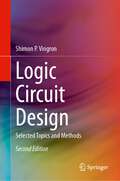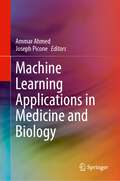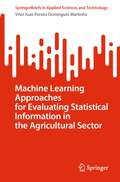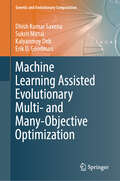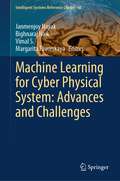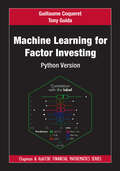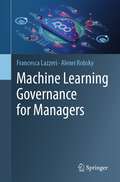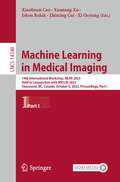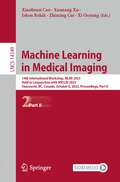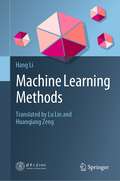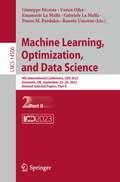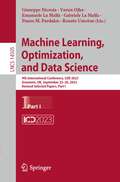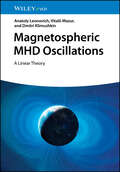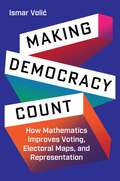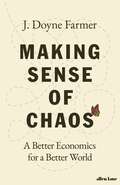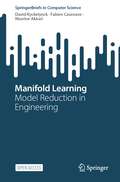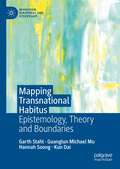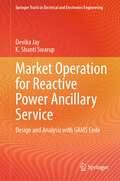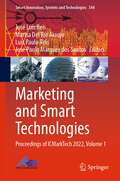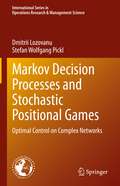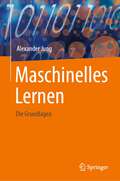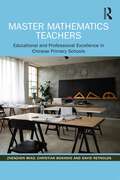- Table View
- List View
Logic Circuit Design: Selected Topics and Methods
by Shimon P. VingronThe 2nd edition has been thoroughly revised and is intended as a wakeup call in the stagnant and dormant field of switching algebra and logic circuit design. It presents the material in a concise but thorough way. The topics selected are an in-depth presentation of switching algebra, a theory of memory circuits (sometimes called flop flops), a new approach to asynchronous circuits, and a newly added part presenting a unique programming technique (or language) for programmable logic controllers (PLCs). Be ready for the unorthodox and controversial.
Machine Learning Applications in Medicine and Biology
by Ammar Ahmed Joseph PiconeThis book combines selected papers from the 2022 IEEE Signal Processing in Medicine and Biology Symposium (IEEE SPMB) held at Temple University. The symposium presents multidisciplinary research in the life sciences. Topics covered include:Signal and image analysis (EEG, ECG, MRI)Machine learningData mining and classificationBig data resourcesApplications of particular interest at the 2022 symposium included digital pathology, computational biology, and quantum computing. The book features tutorials and examples of successful applications that will appeal to a wide range of professionals and researchers in signal processing, medicine, and biology.
Machine Learning Approaches for Evaluating Statistical Information in the Agricultural Sector (SpringerBriefs in Applied Sciences and Technology)
by Vitor Joao MartinhoThis book presents machine learning approaches to identify the most important predictors of crucial variables for dealing with the challenges of managing production units and designing agriculture policies. The book focuses on the agricultural sector in the European Union and considers statistical information from the Farm Accountancy Data Network (FADN).Presently, statistical databases present a lot of information for many indicators and, in these contexts, one of the main tasks is to identify the most important predictors of certain indicators. In this way, the book presents approaches to identifying the most relevant variables that best support the design of adjusted farming policies and management plans. These subjects are currently important for students, public institutions and farmers. To achieve these objectives, the book considers the IBM SPSS Modeler procedures as well as the respective models suggested by this software.The book is read by students in production engineering, economics and agricultural studies, public bodies and managers in the farming sector.
Machine Learning Assisted Evolutionary Multi- and Many- Objective Optimization (Genetic and Evolutionary Computation)
by Dhish Kumar Saxena Sukrit Mittal Kalyanmoy Deb Erik D. GoodmanThis book focuses on machine learning (ML) assisted evolutionary multi- and many-objective optimization (EMâO). EMâO algorithms, namely EMâOAs, iteratively evolve a set of solutions towards a good Pareto Front approximation. The availability of multiple solution sets over successive generations makes EMâOAs amenable to application of ML for different pursuits. Recognizing the immense potential for ML-based enhancements in the EMâO domain, this book intends to serve as an exclusive resource for both domain novices and the experienced researchers and practitioners. To achieve this goal, the book first covers the foundations of optimization, including problem and algorithm types. Then, well-structured chapters present some of the key studies on ML-based enhancements in the EMâO domain, systematically addressing important aspects. These include learning to understand the problem structure, converge better, diversify better, simultaneously converge and diversify better, and analyze the Pareto Front. In doing so, this book broadly summarizes the literature, beginning with foundational work on innovization (2003) and objective reduction (2006), and extending to the most recently proposed innovized progress operators (2021-23). It also highlights the utility of ML interventions in the search, post-optimality, and decision-making phases pertaining to the use of EMâOAs. Finally, this book shares insightful perspectives on the future potential for ML based enhancements in the EMâOA domain.To aid readers, the book includes working codes for the developed algorithms. This book will not only strengthen this emergent theme but also encourage ML researchers to develop more efficient and scalable methods that cater to the requirements of the EMâOA domain. It serves as an inspiration for further research and applications at the synergistic intersection of EMâOA and ML domains.
Machine Learning for Cyber Physical System: Advances and Challenges (Intelligent Systems Reference Library #60)
by Janmenjoy Nayak Bighnaraj Naik Vimal S. Margarita FavorskayaThis book provides a comprehensive platform for learning the state-of-the-art machine learning algorithms for solving several cybersecurity issues. It is helpful in guiding for the implementation of smart machine learning solutions to detect various cybersecurity problems and make the users to understand in combating malware, detect spam, and fight financial fraud to mitigate cybercrimes. With an effective analysis of cyber-physical data, it consists of the solution for many real-life problems such as anomaly detection, IoT-based framework for security and control, manufacturing control system, fault detection, smart cities, risk assessment of cyber-physical systems, medical diagnosis, smart grid systems, biometric-based physical and cybersecurity systems using advance machine learning approach. Filling an important gap between machine learning and cybersecurity communities, it discusses topics covering a wide range of modern and practical advance machine learning techniques, frameworks, and development tools to enable readers to engage with the cutting-edge research across various aspects of cybersecurity.
Machine Learning for Factor Investing: Python Version (Chapman and Hall/CRC Financial Mathematics Series)
by Guillaume Coqueret Tony GuidaMachine learning (ML) is progressively reshaping the fields of quantitative finance and algorithmic trading. ML tools are increasingly adopted by hedge funds and asset managers, notably for alpha signal generation and stocks selection. The technicality of the subject can make it hard for non-specialists to join the bandwagon, as the jargon and coding requirements may seem out-of-reach. Machine learning for factor investing: Python version bridges this gap. It provides a comprehensive tour of modern ML-based investment strategies that rely on firm characteristics. The book covers a wide array of subjects which range from economic rationales to rigorous portfolio back-testing and encompass both data processing and model interpretability. Common supervised learning algorithms such as tree models and neural networks are explained in the context of style investing and the reader can also dig into more complex techniques like autoencoder asset returns, Bayesian additive trees and causal models. All topics are illustrated with self-contained Python code samples and snippets that are applied to a large public dataset that contains over 90 predictors. The material, along with the content of the book, is available online so that readers can reproduce and enhance the examples at their convenience. If you have even a basic knowledge of quantitative finance, this combination of theoretical concepts and practical illustrations will help you learn quickly and deepen your financial and technical expertise.
Machine Learning for Factor Investing: Python Version (Chapman and Hall/CRC Financial Mathematics Series)
by Guillaume Coqueret Tony GuidaMachine learning (ML) is progressively reshaping the fields of quantitative finance and algorithmic trading. ML tools are increasingly adopted by hedge funds and asset managers, notably for alpha signal generation and stocks selection. The technicality of the subject can make it hard for non-specialists to join the bandwagon, as the jargon and coding requirements may seem out-of-reach. Machine learning for factor investing: Python version bridges this gap. It provides a comprehensive tour of modern ML-based investment strategies that rely on firm characteristics. The book covers a wide array of subjects which range from economic rationales to rigorous portfolio back-testing and encompass both data processing and model interpretability. Common supervised learning algorithms such as tree models and neural networks are explained in the context of style investing and the reader can also dig into more complex techniques like autoencoder asset returns, Bayesian additive trees and causal models. All topics are illustrated with self-contained Python code samples and snippets that are applied to a large public dataset that contains over 90 predictors. The material, along with the content of the book, is available online so that readers can reproduce and enhance the examples at their convenience. If you have even a basic knowledge of quantitative finance, this combination of theoretical concepts and practical illustrations will help you learn quickly and deepen your financial and technical expertise.
Machine Learning Governance for Managers
by Francesca Lazzeri Alexei RobskyMachine Learning Governance for Managers provides readers with the knowledge to unlock insights from data and leverage AI solutions. In today's business landscape, most organizations face challenges in scaling and maintaining a sustainable machine learning model lifecycle. This book offers a comprehensive framework that covers business requirements, data generation and acquisition, modeling, model deployment, performance measurement, and management, providing a range of methodologies, technologies, and resources to assist data science managers in adopting data and AI-driven practices. Particular emphasis is given to ramping up a solution quickly, detailing skills and techniques to ensure the right things are measured and acted upon for reliable results and high performance. Readers will learn sustainable tools for implementing machine learning with existing IT and privacy policies, including versioning all models, creating documentation, monitoring models and their results, and assessing their causal business impact. By overcoming these challenges, bottom-line gains from AI investments can be realized. Organizations that implement all aspects of AI/ML model governance can achieve a high level of control and visibility over how models perform in production, leading to improved operational efficiency and a higher ROI on AI investments. Machine Learning Governance for Managers helps to effectively control model inputs and understand all the variables that may impact your results. Don't let challenges in machine learning hinder your organization's growth - unlock its potential with this essential guide.
Machine Learning in Medical Imaging: 14th International Workshop, MLMI 2023, Held in Conjunction with MICCAI 2023, Vancouver, BC, Canada, October 8, 2023, Proceedings, Part I (Lecture Notes in Computer Science #14348)
by Xiaohuan Cao Xuanang Xu Islem Rekik Zhiming Cui Xi OuyangThe two-volume set LNCS 14348 and 14139 constitutes the proceedings of the 14th International Workshop on Machine Learning in Medical Imaging, MLMI 2023, held in conjunction with MICCAI 2023, in Vancouver, Canada, in October 2023. The 93 full papers presented in the proceedings were carefully reviewed and selected from 139 submissions. They focus on major trends and challenges in artificial intelligence and machine learning in the medical imaging field, translating medical imaging research into clinical practice. Topics of interests included deep learning, generative adversarial learning, ensemble learning, transfer learning, multi-task learning, manifold learning, reinforcement learning, along with their applications to medical image analysis, computer-aided diagnosis, multi-modality fusion, image reconstruction, image retrieval, cellular image analysis, molecular imaging, digital pathology, etc.
Machine Learning in Medical Imaging: 14th International Workshop, MLMI 2023, Held in Conjunction with MICCAI 2023, Vancouver, BC, Canada, October 8, 2023, Proceedings, Part II (Lecture Notes in Computer Science #14349)
by Xiaohuan Cao Xuanang Xu Islem Rekik Zhiming Cui Xi OuyangThe two-volume set LNCS 14348 and 14139 constitutes the proceedings of the 14th International Workshop on Machine Learning in Medical Imaging, MLMI 2023, held in conjunction with MICCAI 2023, in Vancouver, Canada, in October 2023. The 93 full papers presented in the proceedings were carefully reviewed and selected from 139 submissions. They focus on major trends and challenges in artificial intelligence and machine learning in the medical imaging field, translating medical imaging research into clinical practice. Topics of interests included deep learning, generative adversarial learning, ensemble learning, transfer learning, multi-task learning, manifold learning, reinforcement learning, along with their applications to medical image analysis, computer-aided diagnosis, multi-modality fusion, image reconstruction, image retrieval, cellular image analysis, molecular imaging, digital pathology, etc.
Machine Learning Methods
by Hang LiThis book provides a comprehensive and systematic introduction to the principal machine learning methods, covering both supervised and unsupervised learning methods. It discusses essential methods of classification and regression in supervised learning, such as decision trees, perceptrons, support vector machines, maximum entropy models, logistic regression models and multiclass classification, as well as methods applied in supervised learning, like the hidden Markov model and conditional random fields. In the context of unsupervised learning, it examines clustering and other problems as well as methods such as singular value decomposition, principal component analysis and latent semantic analysis. As a fundamental book on machine learning, it addresses the needs of researchers and students who apply machine learning as an important tool in their research, especially those in fields such as information retrieval, natural language processing and text data mining. In order to understand the concepts and methods discussed, readers are expected to have an elementary knowledge of advanced mathematics, linear algebra and probability statistics. The detailed explanations of basic principles, underlying concepts and algorithms enable readers to grasp basic techniques, while the rigorous mathematical derivations and specific examples included offer valuable insights into machine learning.
Machine Learning, Optimization, and Data Science: 9th International Conference, LOD 2023, Grasmere, UK, September 22–26, 2023, Revised Selected Papers, Part II (Lecture Notes in Computer Science #14506)
by Giuseppe Nicosia Varun Ojha Emanuele La Malfa Gabriele La Malfa Panos M. Pardalos Renato UmetonThis book constitutes the refereed proceedings of the 9th International Conference on Machine Learning, Optimization, and Data Science, LOD 2023, which took place in Grasmere, UK, in September 2023. The 72 full papers included in this book were carefully reviewed and selected from 119 submissions. The proceedings also contain 9 papers from and the Third Symposium on Artificial Intelligence and Neuroscience, ACAIN 2023. The contributions focus on the state of the art and the latest advances in the integration of machine learning, deep learning, nonlinear optimization and data science to provide and support the scientific and technological foundations for interpretable, explainable and trustworthy AI.
Machine Learning, Optimization, and Data Science: 9th International Conference, LOD 2023, Grasmere, UK, September 22–26, 2023, Revised Selected Papers, Part I (Lecture Notes in Computer Science #14505)
by Giuseppe Nicosia Varun Ojha Emanuele La Malfa Gabriele La Malfa Panos M. Pardalos Renato UmetonThis book constitutes the refereed proceedings of the 9th International Conference on Machine Learning, Optimization, and Data Science, LOD 2023, which took place in Grasmere, UK, in September 2023. The 72 full papers included in this book were carefully reviewed and selected from 119 submissions. The proceedings also contain 9 papers from and the Third Symposium on Artificial Intelligence and Neuroscience, ACAIN 2023. The contributions focus on the state of the art and the latest advances in the integration of machine learning, deep learning, nonlinear optimization and data science to provide and support the scientific and technological foundations for interpretable, explainable and trustworthy AI.
Magnetoelectronic, Optical, and Thermoelectric Properties of Perovskite Materials (SpringerBriefs in Materials)
by Rachid MasrourThis book undertakes an extensive exploration of manganese-based compounds, such as T₁₋ₓSrxMnO₃ (T = La, Pr; x = 0.35, 0.25) using density functional theory and Monte Carlo simulations with a focus on understanding their electronic, magnetic, and magnetocaloric properties. Ba₁₋ₓSrxFeO₃ (x = 0, 0.2) is also studied via different approximations, offering a comparative perspective. In addition, the book looks at the influence of magnetism using Monte Carlo simulations, revealing crucial parameters and examining the GdCrO₃ system through DFT and Monte Carlo simulation, shedding light on recent experimental observations. Additionally, Monte Carlo studies investigate magnetic and magnetocaloric features of Sr₂FeMoO₆, La₂SrMn₂O₇ bilayer manganite, perovskite ferromagnetic thin films' surface effects, and SmFe₁₋ₓMnxO₃ perovskite. In essence, this book significantly advances our comprehension of magnetic and magnetocaloric phenomena across diverse materials and is well-suited for both experimentalists and computational researchers working in this field.
Magnetospheric MHD Oscillations: A Linear Theory
by Anatoly Leonovich Dmitri Klimushkin Vitalii MazurMagnetospheric MHD Oscillations A groundbreaking new theory of the magnetosphere The magnetosphere is the region around Earth in which our planet’s magnetic field exerts its influence to trap charged particles. Waves in this magnetosphere, known as magnetohydrodynamic (MHD) oscillations, are caused by interactions between these charged particles, Solar wind pulses, and the magnetic field. The predictable interval between these oscillations enables them to serve as tools for understanding the magnetospheric plasma which comprises the field. Magnetospheric MHD Oscillations offers a comprehensive overview of the theory underlying these waves and their periodicity. Emphasizing the spatial structure of the oscillations, it advances a theory of MHD oscillation that promises to have significant ramifications in astronomy and beyond. Magnetospheric MHD Oscillations readers will also find: Theorizing of direct relevance to current satellite missions, such as THEMIS and the Van Allen Probe In-depth discussion of topics including Alfven resonance, waveguides in plasma filaments, and many more Detailed appendices including key calculations and statistical parameters Magnetospheric MDH Oscillations is ideal for plasma physicists, theoretical physicists, applied mathematicians, and advanced graduate students in these and related subfields.
Magnetospheric MHD Oscillations: A Linear Theory
by Anatoly Leonovich Dmitri Klimushkin Vitalii MazurMagnetospheric MHD Oscillations A groundbreaking new theory of the magnetosphere The magnetosphere is the region around Earth in which our planet’s magnetic field exerts its influence to trap charged particles. Waves in this magnetosphere, known as magnetohydrodynamic (MHD) oscillations, are caused by interactions between these charged particles, Solar wind pulses, and the magnetic field. The predictable interval between these oscillations enables them to serve as tools for understanding the magnetospheric plasma which comprises the field. Magnetospheric MHD Oscillations offers a comprehensive overview of the theory underlying these waves and their periodicity. Emphasizing the spatial structure of the oscillations, it advances a theory of MHD oscillation that promises to have significant ramifications in astronomy and beyond. Magnetospheric MHD Oscillations readers will also find: Theorizing of direct relevance to current satellite missions, such as THEMIS and the Van Allen Probe In-depth discussion of topics including Alfven resonance, waveguides in plasma filaments, and many more Detailed appendices including key calculations and statistical parameters Magnetospheric MDH Oscillations is ideal for plasma physicists, theoretical physicists, applied mathematicians, and advanced graduate students in these and related subfields.
Making Democracy Count: How Mathematics Improves Voting, Electoral Maps, and Representation
by Ismar VolićHow we can repair our democracy by rebuilding the mechanisms that power itWhat’s the best way to determine what most voters want when multiple candidates are running? What’s the fairest way to allocate legislative seats to different constituencies? What’s the least distorted way to draw voting districts? Not the way we do things now. Democracy is mathematical to its very foundations. Yet most of the methods in use are a historical grab bag of the shortsighted, the cynical, the innumerate, and the outright discriminatory. Making Democracy Count sheds new light on our electoral systems, revealing how a deeper understanding of their mathematics is the key to creating civic infrastructure that works for everyone.In this timely guide, Ismar Volić empowers us to use mathematical thinking as an objective, nonpartisan framework that rises above the noise and rancor of today’s divided public square. Examining our representative democracy using powerful clarifying concepts, Volić shows why our current voting system stifles political diversity, why the size of the House of Representatives contributes to its paralysis, why gerrymandering is a sinister instrument that entrenches partisanship and disenfranchisement, why the Electoral College must be rethought, and what can work better and why. Volić also discusses the legal and constitutional practicalities involved and proposes a road map for repairing the mathematical structures that undergird representative government.Making Democracy Count gives us the concrete knowledge and the confidence to advocate for a more just, equitable, and inclusive democracy.
Making Sense of Chaos: A Better Economics for a Better World
by J. Doyne Farmer‘Doyne Farmer is the world's leading thinker on technological change. For decades he has focused on the question of how we can make sense of the data of today to see where the world is going tomorrow. This wonderful book applies these insights to economics, addressing the big global issues of environmental sustainability, and the well-being and prosperity of people around the world’ Max Roser, Founder of Our World in DataWe live in an age of increasing complexity, where accelerating technology and global interconnection hold more promise – and more peril – than any other time in human history. As well as financial crises, issues around climate change, automation, growing inequality and polarization are all rooted in the economy, yet standard economic predictions fail us.Many books have been written about Doyne Farmer and his pioneering work in chaos and complexity theory. Making Sense of Chaos is the first in his own words, presenting a manifesto for doing economics better. In a tale of science and ideas, Farmer fuses his profound knowledge with stories from his life to explain how to harness a scientific revolution to address the economic conundrums facing society.Using big data and ever more powerful computers, we can for the first time apply complex systems science to economic activity, building realistic models of the global economy. The resulting simulations and the emergent behaviour we observe form the cornerstone of complexity economics. This new science, Farmer shows, will allow us to test ideas and make significantly better economic predictions – and, ultimately, create a better world.
Manifold Learning: Model Reduction in Engineering (SpringerBriefs in Computer Science)
by David Ryckelynck Fabien Casenave Nissrine AkkariThis Open Access book reviews recent theoretical and numerical developments in nonlinear model order reduction in continuum mechanics, being addressed to Master and PhD students, as well as to researchers, lecturers and instructors. The aim of the authors is to provide tools for a better understanding and implement reduced order models by using: physics-based models, synthetic data forecast by these models, experimental data and deep learning algorithms. The book involves a survey of key methods of model order reduction applied to model-based engineering and digital twining, by learning linear or nonlinear latent spaces.Projection-based reduced order models are the projection of mechanical equations on a latent space that have been learnt from both synthetic data and experimental data. Various descriptions and representations of structured data for model reduction are presented in the applications and survey chapters. Image-based digital twins are developed in a reduced setting. Reduced order models of as-manufactured components predict the mechanical effects of shape variations. A similar workflow is extended to multiphysics or coupled problems, with high dimensional input fields. Practical techniques are proposed for data augmentation and also for hyper-reduction, which is a key point to speed up projection-based model order reduction of finite element models.The book gives access to python libraries available on gitlab.com, which have been developed as part of the research program [FUI-25] MORDICUS funded by the French government. Similarly to deep learning for computer vision, deep learning for model order reduction circumvents the need to design parametric problems prior reducing models. Such an approach is highly relevant for image-base modelling or multiphysics modelling.
Mapping Transnational Habitus: Epistemology, Theory and Boundaries (Migration, Diasporas and Citizenship)
by Garth Stahl Guanglun Michael Mu Hannah Soong Kun DaiThis book surveys and critiques existing empirical and theoretical literature on the Bourdieu-informed concept of transnational habitus. The term "transnational” has been used widely in studies of migration research where it has allowed scholars to have a deeper understanding of the practices not only of migrants moving across national borders but also of agents taking positions in transnational spaces without necessarily criss-crossing different nation states. Focusing on the potential of transnational habitus as an analytical tool, the authors propose a model of transnational habitus to identify integral key factors for the operationalisation in research. Drawing on reflexivity, the authors analyse transnational selves and map transnational spaces of classification. Identifying strengths, inconsistencies and key problems in this rapidly developing body of literature, this interdisciplinary and international book will be of interest to students and scholars in sociology, anthropology, migration studies, cultural studies, human geography, as well as diaspora studies.
Market Operation for Reactive Power Ancillary Service: Design and Analysis with GAMS Code (Springer Tracts in Electrical and Electronics Engineering)
by Devika Jay K. Shanti SwarupThis book provides a framework suitable for the design and analysis of market mechanisms suitable for reactive power ancillary service. The book focuses on the formulation of market mechanisms capable of handling the localized nature of reactive power. The book presents tools and methodologies to design a suitable market structure capable of handling the technical challenges associated with the reactive power market like localized nature or reactive power, voltage support requirement, reactive power reserve requirement, and coupling between active reactive power markets. The book also presents techniques suitable for analyzing the market efficiency of different market mechanisms for reactive power ancillary service. The key topics discussed in this book include the relevance and challenges of reactive power ancillary service; the design of market mechanisms; network partitioning techniques to handle the localized nature of reactive power; and analysis of market mechanisms for market efficiency. This book is helpful for researchers and graduate students to know about recent advances in this area. Practitioners find the book helpful for understanding how technological advances can be put into practice and learning from case studies that bring out practical challenges.
Marketing and Smart Technologies: Proceedings of ICMarkTech 2022, Volume 1 (Smart Innovation, Systems and Technologies #344)
by José Luís Reis Marisa Del Rio Araujo Luís Paulo Reis José Paulo Marques dos SantosThis book includes selected papers presented at the International Conference on Marketing and Technologies (ICMarkTech 2022), held at Universidade de Santiago de Compostela, Spain, during 1 – 3 December 2022. It covers up-to-date cutting-edge research on artificial intelligence applied in marketing, virtual and augmented reality in marketing, business intelligence databases and marketing, data mining and big data, marketing data science, web marketing, e-commerce and v-commerce, social media and networking, geomarketing and IoT, marketing automation and inbound marketing, machine learning applied to marketing, customer data management and CRM, and neuromarketing technologies.
Markov Decision Processes and Stochastic Positional Games: Optimal Control on Complex Networks (International Series in Operations Research & Management Science #349)
by Dmitrii Lozovanu Stefan Wolfgang PicklThis book presents recent findings and results concerning the solutions of especially finite state-space Markov decision problems and determining Nash equilibria for related stochastic games with average and total expected discounted reward payoffs. In addition, it focuses on a new class of stochastic games: stochastic positional games that extend and generalize the classic deterministic positional games. It presents new algorithmic results on the suitable implementation of quasi-monotonic programming techniques. Moreover, the book presents applications of positional games within a class of multi-objective discrete control problems and hierarchical control problems on networks. Given its scope, the book will benefit all researchers and graduate students who are interested in Markov theory, control theory, optimization and games.
Maschinelles Lernen: Die Grundlagen
by Alexander JungMaschinelles Lernen (ML) ist zu einem alltäglichen Element in unserem Leben und zu einem Standardwerkzeug für viele Bereiche der Wissenschaft und Technik geworden. Um ML optimal nutzen zu können, ist es wichtig, die zugrunde liegenden Prinzipien zu verstehen. In diesem Buch wird ML als die rechnerische Umsetzung des wissenschaftlichen Prinzips betrachtet. Dieses Prinzip besteht darin, ein Modell eines gegebenen datenerzeugenden Phänomens kontinuierlich anzupassen, indem eine Form des Verlustes, der durch seine Vorhersagen entsteht, minimiert wird.Das Buch schult den Leser darin, verschiedene ML-Anwendungen und -Methoden in drei Komponenten (Daten, Modell und Verlust) aufzuschlüsseln, und hilft ihm so, aus dem riesigen Angebot an vorgefertigten ML-Methoden auszuwählen.Der Drei-Komponenten-Ansatz des Buches erlaubt eine einheitliche und transparente Darstellung verschiedener ML-Techniken. Wichtige Methoden zu Regularisierung, zum Schutz der Privatsphäre und zur Erklärbarkeit von ML-Methoden sind Spezialfälle dieses Drei-Komponenten-Ansatz.
Master Mathematics Teachers: Educational and Professional Excellence in Chinese Primary Schools
by Zhenzhen Miao Christian Bokhove David ReynoldsThis practical guide invites teachers to take a journey towards masterly mathematics teaching using the experiences and lessons learnt across five Chinese provinces, Anhui, Beijing, Jiangsu, Jiangxi and Tianjin.On this journey, you will gain a thorough understanding of: (1) the quality and characteristics of master mathematics teachers’ teaching, (2) the quality of mathematics learning they have nurtured amongst their students in affective, metacognitive and cognitive dimensions and (3) the teaching-learning mechanisms that underpin excellent performance in the three dimensions. Alongside the quantitative and qualitative evidence on educational excellence, you will also delve deep into the trajectories and processes of professional development that generate professional excellence amongst master mathematics teachers and their peers within and across primary schools, up and down China.Building on data collected with 70 master mathematics teachers and 3,178 students and from teaching research events at the school, municipal, provincial and national levels, the Master Mathematics Teachers (MasterMT) project is, to date, the first that has looked at the legendary tribe of master mathematics teachers in China at such a large scale, and with such breadth and depth. The book offers invaluable insights for any teacher or teacher educator who wants to improve mathematics teaching and learning and generate educational and professional excellence in primary schools and beyond.More information on the Master Mathematics Teachers (MasterMT) project can be accessed at https://mastermt.org/.
